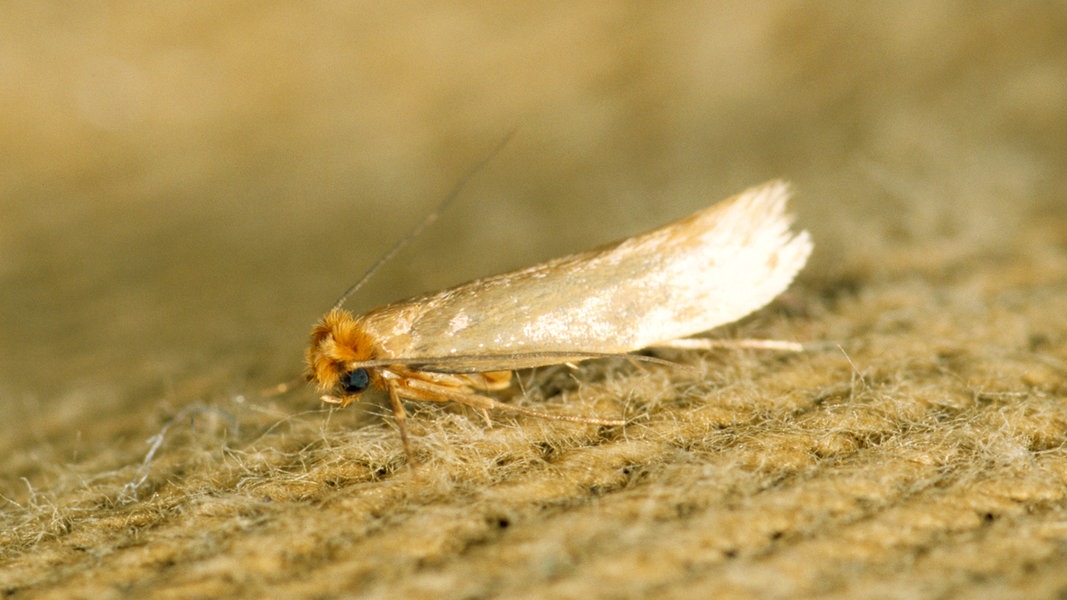Status: 04.07.2023 12:49 p.m
They damage textiles, but should be fought as gently as possible for health reasons. What do the moths look like, how do you find them and what can you do against the pests?
The clothes moth (Tineola bisselliella) feeds on animal hair in nature. However, she also likes to choose living and storage rooms as her habitat. The females feel particularly comfortable in dark wardrobes, where they lay their eggs on wool, fur or other clothing. They also like upholstered furniture, blankets and carpets. Clothes moths cause feeding holes in textiles, but are not harmful to our health. Since they usually do not disappear on their own, those affected should do something about the moths.
Identify clothes moths and larvae
Clothes moths are about four to nine millimeters long when fully grown and can be recognized by their straw-colored, silky bodies and forewings. Unlike other moths, such as food moths, they have no spots or markings. When at rest, the forewings lie over the grey-yellow hindwings. The whitish-yellow larvae need the protein keratin contained in animal hair. They are about seven to nine millimeters long and have a yellow-brown head with a black rear edge.
Eggs, small holes and webs: recognize infestation
Like all moths, the clothes moth goes through the stages of development from egg to larva and pupa to moth. A female lays 50 to 250 eggs. However, the eggs, which are only about 0.6 millimeters in size, are hardly visible on textiles and fur. An infestation is usually only recognized when there are many small, irregularly distributed larvae feeding holes in textiles.
In addition, the moths leave delicate, white threads on and in fabrics – the webs. These are found on smooth textiles on the surface, and on wool and fur they are usually deeper. Another indication of clothes moths are small lumps of droppings that are similar in color to the infested fabric.
Set up sticky pheromone traps
The Federal Environment Agency recommends setting up so-called pheromone sticky traps if an infestation is suspected. The traps contain sex attractants that attract male animals. If the adhesive strips are placed in several places, the central focus of infestation can be found more easily. In addition, the traps limit the reproduction of the animals. Sticky pheromone traps are available at specialty stores, drugstores, hardware stores, or online. However, attractant traps are not enough to really get rid of moths.
Avoid chemical and biological agents as much as possible
Various chemical and biological agents are available to control clothes moths. Since, according to the Federal Environment Agency, some can be toxic to humans and the environment, their use should be avoided if possible. Usually a combination of alternative measures leads to the goal. In the case of stubborn, recurring infestations, a competent pest controller should be consulted, the authority advises.
Combat clothes moths: Choose gentle methods
Clothes moths can usually be successfully combated with gentle measures. Tips in case of an infestation:
Set up sticky traps to find the central point of the infestation Dispose of infested textiles in a sealed plastic bag with the household waste Thoroughly vacuum the area around infested textiles (especially joints, skirting boards, furniture cracks) Thoroughly clean all surfaces with vinegar water and dry completely Blow dry hard-to-reach areas Repeat these measures several times over a period of weeks
Undamaged textiles from the vicinity of the infestation should also be thoroughly washed, beaten and vacuumed. After cleaning, spread out the textiles, dry them in the sunlight and turn them regularly.
Expose unwashable textiles to heat and cold
Larvae and eggs in non-washable textiles such as tapestries and furs can be killed in the oven. The Federal Environment Agency recommends placing the textiles in the oven at 50 to 60 degrees for an hour. Because there is a potential fire hazard, you should stay close during this time. Heat-sensitive textiles should be frozen at minus 18 degrees for a week to kill all the animals. Repeat the process again after three weeks.
Parasitic wasp: Natural enemy of the clothes moth
Ichneumon wasps are useful for fighting clothes moths.
In the case of a severe infestation, parasitic wasps can help. The small insects are natural enemies of the clothes moth, but are harmless to humans and pets. Ichneumon wasps lay their eggs in the moth eggs, which then die. They disappear again as soon as there are no more new moth eggs available.
Preparations with living parasitic wasps are available in hardware stores, specialist shops and on the Internet. The Federal Environment Agency advises using these over a period of about four and a half months.
Natural Insecticide: Neem
The plant extract neem (or neem), which is obtained from the leaves of the tropical neem tree, can also be used as a natural insecticide against clothes moths. A few days after treatment, the moth larvae die. The Federal Environment Agency points out that competent use is also important for natural toxins.
Prevent clothes moths
To prevent an infestation by clothes moths, the following measures can be used:
Attach fly screens to windows and doorsWash unused textiles made of wool, fur and feathers (blankets, pillows) and stow them away in garment bags.Blow blankets, tapestries and furs regularly, air them and place them in the sun.Scented sachets go.Moths in wardrobes (e.g. with lavender or cedar wood)
Further information
The larvae of hoverflies and lacewings help against pests such as whiteflies. You can plant them in the garden. more
Strange webs can be found in many trees and bushes in early summer. They come from the spider moth. What to do? more
Campodorus paradiesensis is a new species of parasitic wasp that an insect expert discovered in his garden in Mohrkirch. more
This topic in the program:
The Northern Report | 02/20/2023 | 2:15 a.m
